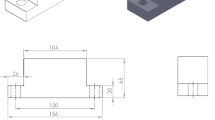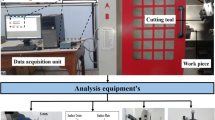Abstract
Materials with high hardness are usually difficult to machine, and accomplishing precise and economical machining depends on all the cutting conditions. Appropriate tool geometry is one important aspect for the cutting process that can be optimized based on the machining parameters. In this study, the finite element simulation method was applied to analyze the effects of tool geometry on the cutting forces and tool temperature during the ball end milling of tool steel (AISI H13). Multi-objective optimization of the geometrical parameters was performed using the grey relational method, which gave a set of input parameters to obtain the minimum cutting forces and temperature. The findings of this work could be used as a basis for tool design. Experiments were conducted with mono-objective and multi-objective optimal geometries to validate the finite element analysis. The finite element and experimental results were both congruous with an error limit of 5%.














Similar content being viewed by others
References
Liang, Z., et al. (2018). Fabrication and milling performance of micro ball-end mills with different relief angles. International Journal of Advanced Manufacturing Technology, 98(1–4), 919–928. https://doi.org/10.1007/s00170-018-2307-0
Senthilkumar, N., Tamizharasan, T., & Anandakrishnan, V. (2014). Experimental investigation and performance analysis of cemented carbide inserts of different geometries using Taguchi based grey relational analysis. Measurement: Journal of the International Measurement Confederation, 58, 520–536. https://doi.org/10.1016/j.measurement.2014.09.025
Özel, T., Hsu, T. K., & Zeren, E. (2005). Effects of cutting edge geometry, workpiece hardness, feed rate and cutting speed on surface roughness and forces in finish turning of hardened AISI H13 steel. International Journal of Advanced Manufacturing Technology, 25(3–4), 262–269. https://doi.org/10.1007/s00170-003-1878-5
Meral, G., Sarıkaya, M., Mia, M., Dilipak, H., Şeker, U., & Gupta, M. K. (2019). Multi-objective optimization of surface roughness, thrust force, and torque produced by novel drill geometries using Taguchi-based GRA. International Journal of Advanced Manufacturing Technology. https://doi.org/10.1007/s00170-018-3061-z
Ma, J. W., Jia, Z. Y., He, G. Z., Liu, Z., Zhao, X. X., & Qin, F. Z. (2019). Influence of cutting tool geometrical parameters on tool wear in high-speed milling of Inconel 718 curved surface. Proceedings of the Institution of Mechanical Engineers, Part B: Journal of Engineering Manufacture, 233(1), 18–30. https://doi.org/10.1177/0954405417716495
Izamshah, R., Yuhazri, M. Y., Hadzley, M., Amran, M., & Subramonian, S. (2013). Effects of end mill helix angle on accuracy for machining Thin-Rib Aerospace Component. https://doi.org/10.4028/www.scientific.net/AMM.315.773.
Kuppuswamy, R., Bower, D., & March, P. (2014). Blend of sharpness and strength on a ball nose endmill geometry for high speed machining of Ti6Al4V. International Journal of Advanced Manufacturing Technology. https://doi.org/10.1007/s00170-013-5345-7
Sivasakthivel, P. S., Sudhakaran, R., & Rajeswari, S. (2017). Optimization and sensitivity analysis of geometrical and process parameters to reduce vibration during end milling process. Machining Science and Technology. https://doi.org/10.1080/10910344.2017.1284564
Subramanian, M., Sakthivel, M., Sooryaprakash, K., & Sudhakaran, R. (2013). Optimization of end mill tool geometry parameters for Al7075-T6 machining operations based on vibration amplitude by response surface methodology. Measurement: Journal of the International Measurement Confederation, 46(10), 4005–4022. https://doi.org/10.1016/j.measurement.2013.08.015
Vipindas, K., Anand, K. N., & Mathew, J. (2018). Effect of cutting edge radius on micro end milling: force analysis, surface roughness, and chip formation. International Journal of Advanced Manufacturing Technology. https://doi.org/10.1007/s00170-018-1877-1
Biondani, F. G., & Bissacco, G. (2019). Effect of cutting edge micro geometry on surface generation in ball end milling. CIRP Annals, 68(1), 571–574. https://doi.org/10.1016/j.cirp.2019.04.017
Yen, Y. C., Jain, A., & Altan, T. (2004). A finite element analysis of orthogonal machining using different tool edge geometries. Journal of Materials Processing Technology, 146(1), 72–81. https://doi.org/10.1016/S0924-0136(03)00846-X
Liu, K., & Melkote, S. N. (2007). Finite element analysis of the influence of tool edge radius on size effect in orthogonal micro-cutting process. International Journal of Mechanical Sciences, 49(5), 650–660. https://doi.org/10.1016/j.ijmecsci.2006.09.012
Soo, S. L., Dewes, R. C., & Aspinwall, D. K. (2010). 3D FE modelling of high-speed ball nose end milling. International Journal of Advanced Manufacturing Technology. https://doi.org/10.1007/s00170-010-2581-y
Yang, K., Liang, Y. C., Zheng, K. N., Bai, Q. S., & Chen, W. Q. (2011). Tool edge radius effect on cutting temperature in micro-end-milling process. International Journal of Advanced Manufacturing Technology, 52(9–12), 905–912. https://doi.org/10.1007/s00170-010-2795-z
Chen, C. H., Wang, Y. C., & Lee, B. Y. (2013). The optimal design of micro end mill for milling SKD61 tool steel. International Journal of Advanced Manufacturing Technology, 68(1–4), 165–173. https://doi.org/10.1007/s00170-012-4716-9
Cheng, Y., Yang, J., Qin, C., & Zuo, D. (2019). Tool design and cutting parameter optimization for side milling blisk. International Journal of Advanced Manufacturing Technology, 100(9–12), 2495–2508. https://doi.org/10.1007/s00170-018-2846-4
Zhou, L., Li, F., Zhao, F., Li, J., & Sutherland, J. W. (2019). Characterizing the effect of process variables on energy consumption in end milling. International Journal of Advanced Manufacturing Technology, 101(9–12), 2837–2848. https://doi.org/10.1007/s00170-018-3015-5
Grzesik, W., Bartoszuk, M., & Nieslony, P. (2005). Finite element modelling of temperature distribution in the cutting zone in turning processes with differently coated tools. Journal of Materials Processing Technology, 164–165, 1204–1211. https://doi.org/10.1016/j.jmatprotec.2005.02.136
Markopoulos, A. P., Kantzavelos, K., Galanis, N. I., & Manolakos, D. E. (2011). 3D finite element modeling of High Speed Machining. Internationl Journal of Manufacturing Materials and Mechnics Engineering, 1(4), 1–18. https://doi.org/10.4018/ijmmme.2011100101
Ning, Y., Rahman, M., & Wong, Y. S. (2001). Investigation of chip formation in high speed end milling. Journal of Materials Processing Technology, 113(1–3), 360–367. https://doi.org/10.1016/S0924-0136(01)00628-8
Kasim, M. S., et al. (2019). Chip morphology in ball nose end milling process of nickel-based alloy material under MQL condition. Internationl Journal of Advane Manufacturing Technology. https://doi.org/10.1007/s00170-019-03948-z
Arrazola, P. J., Arriola, I., & Davies, M. A. (2009). Analysis of the influence of tool type, coatings, and machinability on the thermal fields in orthogonal machining of AISI 4140 steels. CIRP Annual Manufacturing and Technology, 58(1), 85–88. https://doi.org/10.1016/j.cirp.2009.03.085
Wu, T., Cheng, K., & Rakowski, R. (2012). Investigation on tooling geometrical effects of micro tools and the associated micro milling performance. Proceedings of the Institution of Mechanical Engineers, Part B: Journal of Engineering Manufacture., 226(9), 1442–1453. https://doi.org/10.1177/0954405412449229
Gao, Y., & Tian, G. Y. (2018). Emissivity correction using spectrum correlation of infrared and visible images. Sensors Actuators, A Phys., 270, 8–17. https://doi.org/10.1016/j.sna.2017.12.027
Acknowledgements
This research was supported by the National Research Foundation of Korea (NRF) grant funded by the Korea government (MSIT) (No. NRF-2020R1A2B5B02001755)
Author information
Authors and Affiliations
Corresponding author
Additional information
Publisher's Note
Springer Nature remains neutral with regard to jurisdictional claims in published maps and institutional affiliations.
Rights and permissions
About this article
Cite this article
Ahmed, F., Ko, T.J., Jongmin, L. et al. Tool Geometry Optimization of a Ball End Mill based on Finite Element Simulation of Machining the Tool Steel-AISI H13 using Grey Relational Method. Int. J. Precis. Eng. Manuf. 22, 1191–1203 (2021). https://doi.org/10.1007/s12541-021-00530-0
Received:
Revised:
Accepted:
Published:
Issue Date:
DOI: https://doi.org/10.1007/s12541-021-00530-0




